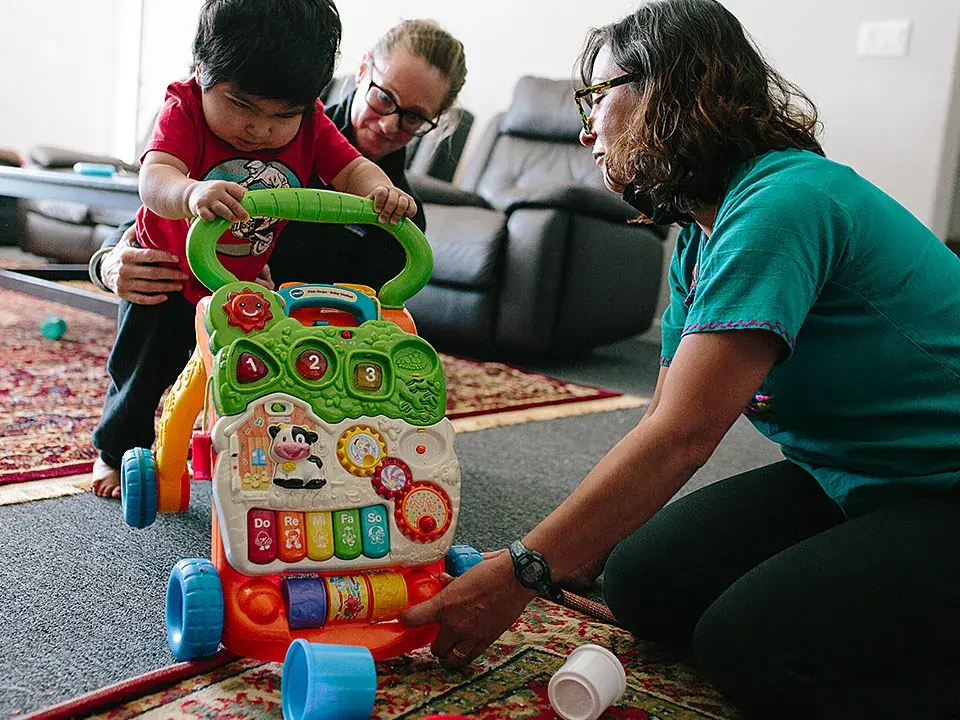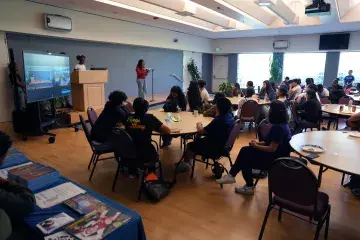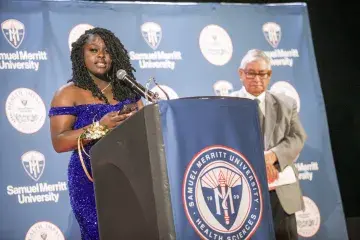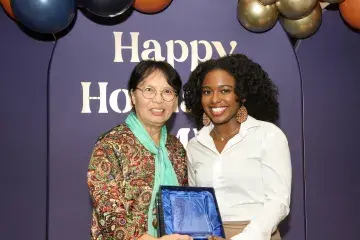A Place to Thrive

When Gul Ahmad Samimi began receiving threats from the Taliban, he made the heart-wrenching decision to leave his home and his family. He fled Afghanistan in 2015, after working for a U.S. aid agency in Kandahar, and promised to bring his family to safety. He piloted a small boat across the Aegean Sea from Turkey to Greece and travelled across seven countries to Germany. In 2018, he came to California and petitioned to bring over his wife and two children.
In Oakland, Gul reunited with his wife and children and started to build a new life. He found a factory job at Tesla and he and his wife, V. Samimi, celebrated the birth of a new son, Farhan. When Farhan was 2, the couple noticed he wasn’t developing like their other children.
“He wasn’t able to walk or do activities he was supposed to do,” says Gul. At first, they thought it was because of the time Farhan had spent in hospitals due to his premature birth. They figured he’d soon adjust.
But SMU Professor Goli Hashemi, MSc, OTR/L, wasn’t so sure. She’d been supporting the Samimis as a “mentor,” a local volunteer for the International Rescue Committee (IRC)—a nonprofit that resettles refugees in the U.S. As an occupational therapist, Goli noticed Farhan’s developmental delays and knew there was something more at play. She encouraged the family to have Farhan assessed by a physician.
Goli recognized that the family needed to work with a rehabilitation team and saw a chance to involve SMU occupational therapy (OT) students, since working with children who have different developmental trajectories is part of their education and profession. Under Goli’s supervision, OT students started visiting the Samimis once or twice a week. They worked with Farhan on gross motor and fine motor skills, communication, and social and self-soothing skills.
They taught Gul and his wife exercises and activities to help improve Farhan’s strength and teach him to walk. The Samimis learned to correct Farhan’s posture when he was sitting in a way that could weaken his muscles. They encouraged Farhan to reach for toys that were just out of his grasp, so he could strengthen his core. And when Farhan was able to stand with the support of a table or wall, they taped drawing paper to the wall to encourage him to color while standing.
Nurhana Rahim, OTD ’22, remembers seeing Farhan take some of his first steps with his mother’s support. “It was incredible to see this kid, who a few months earlier could barely stand on his own, making such huge progress,” she says. “I felt like we were really able to make a difference.”
For Goli, working with refugees and immigrants is personal. When she was 11, her family immigrated to Dubai then Canada from Iran when the country was at war with Iraq. “I have clear memories of what it’s like to live during war,” she says. “It never stops. You’ve heard news about Afghanistan and Ukraine, but you haven’t heard much about Sudan or Yemen. These are wars that have been going on for years, and there are always refugees who need to find safety.”
Goli started volunteering at IRC four years ago. The nonprofit’s clients often endure physical hardship and trauma to relocate. When they arrive, they lack basic necessities: housing, transportation to and from the grocery store, adequate access to healthcare. The more she volunteered the more she saw how SMU OT students could make a difference in refugees’ and immigrants’ lives, while also expanding the students’ understanding of the field’s holistic approach to care.
In the U.S., occupational therapists traditionally worked in hospitals and clinics, helping people learn or relearn to perform activities of daily living. If someone injures their hand, for example, in addition to working on the rehabilitation of the hand, an OT might teach them adaptations to hold their razor differently to shave. Or they might provide an adaptive device or tool that makes shaving easier. It’s different from a physical therapist, who would focus primarily on range of motion, strengthening, exercise, and stretches to help a person recover from a hand injury.
But occupational therapists aren’t limited to the traditional, Goli says, citing her and students’ work with IRC and other nonprofits that serve refugees and immigrants. Life skills training, she says, includes teaching someone to use BART, or taking them to open a bank account, or helping them study for a driver’s license test.
“These everyday life activities all have a ripple effect on a person’s wellness and mental health,” she explains. “Without knowing how to use public transportation or drive a car, it’s very difficult for a person to get a job. Without a job, they will not be able to pay rent or feed their kids. While they may be safe from the trauma of war or persecution, they have different kinds of anxiety and worries that can impact their well-being.”
Plus, while assisting people with these practical needs, Goli and the students are able to screen them for medical needs—like with Farhan.
What is Occupational Therapy?
In addition to connecting with IRC, Goli developed pilot partnerships with the Center for Empowering Refugees and Immigrants (CERI), ARTogether, and Refugee & Immigrant Transitions, all of which support refugees and immigrants. Students can choose to work with these nonprofits for one of their two 12-week fieldwork rotations, or as part of their capstone final project, or as both. Using a trauma - informed approach, the OT students act as “mentors,” lead classes, and facilitate events. So far, 13 students have spent about 5,000 hours doing fieldwork with Bay Area refugee and immigrant communities.
Fieldwork gives students real-world experience practicing what they’ve learned in class. For Rachel Wong, OTD ‘22, working with nonprofits taught her to understand occupational therapy in a new way. “It really broadened my lens and scope to how occupational therapy can be, and how it can impact and help so many people,” she says.
Rachel was used to practicing occupational therapy in traditional medical settings. After graduating with a bachelor’s degree in kinesiology from San Francisco State University, she spent two years volunteering at a hand therapy center at the Sutter Health California Pacific Medical Center Davies Campus. At SMU, her first fieldwork rotation was at an outpatient hand therapy clinic where she provided therapies to heal and help patients learn to perform daily activities. “It was a bit 1, 2, 3,” says Rachel, explaining that her previous experience with hand therapy made the work somewhat automated.
So, when she started her second fieldwork rotation with Goli, Rachel was at first confused as to how community work was a good use of her training. But after diving into the work, she began to understand how that was connected to her mission as an OT. “Everything that we’re doing ultimately serves a larger purpose and ultimately improves a person’s health and their well-being,” she says.
To Pray and to Garden
That’s exactly what Goli wants students to understand. “The skills students learn in their master’s or doctoral occupational therapy program are applicable in any setting, whether in a clinic or out in the community. It’s interesting for students to see, ‘Oh, wow, the traditional medical system, school-based occupational therapy, and private practice aren’t the only place for me to work.’”
For example, Rachel did field work twice a week at CERI. She handed out donations at the food pantry as a way to meet clients and offered to assess their OT needs. One woman, in her 50s, was traumatized as a child growing up in Cambodia under the Khmer Rouge. Her legs were weak and swollen from diabetes, preventing her from doing activities she loved such as attending temple and gardening.
“It opened my eyes, seeing how hard it is for low-income families to get the help they need,” Rachel says.
Over several months, Rachel and other students, under Goli’s supervision, worked with the woman to build upper- and lower-body strength. She learned exercises and practiced getting up and down from the floor—useful for praying at temple and gardening. They also helped the woman develop strategies to reduce her pain, like wearing thick socks to pad her feet, and taught her to use a walker to avoid falls. “She told me that she really liked working with me, and that the OT worked,” Rachel says. “It was meaningful to have helped her make progress in the time we spent together.”
For CERI, having occupational therapy students work with cli- ents has been a gamechanger. About 100 refugees and immigrants, ranging from kids to adults, have received occupational therapy support, says Kate Wadsworth, clinical director of the organization.
“Having OTs at CERI working with refugees and immigrants has allowed more clients to be served, addressing chronic pain and health issues,” Kate says.
Leva Zand, the executive director and founder of the nonprofit ARTogether, says she didn’t know anything about occupational ther- apy until she started working with Goli. Now, she’s “very thankful for the collaboration.” Having SMU OT students available to spot potential health issues that her teachers are unaware of is a huge benefit, she says.
ARTogether’s mission is to provide art programs that foster com- passionate communities for refugees and immigrants to flourish. It hosts a variety of programs, from summer camps for children to art events for adults. At summer camp, the OT students look for kids who may have issues like poor emotion management or motor skills delays. If they find kids who are struggling, they tweak the art activity to better address their needs and reach out to parents to see if they need support.
Home for Displace Souls
For refugees and immigrants, community building is key. Many, like Gul Ahmad Samimi, arrive in the U.S. knowing next to nobody. Creating bonds with others from their own culture helps their emotional and mental well-being, particularly when people begin to feel lonely or depressed. Some of the nation’s largest Afghan communities are in the Bay Area, particularly Fremont, where a section of the city is known as “Little Kabul.”
Goli, who is on the board of ARTogether, has leveraged the non- profit’s resources to host several workshops and gatherings under a community wellness program for newcomers from Afghanistan, Southeast Asia, and Latin America.
Nurhana, and three other occupational therapy students who worked with Gul’s son, Farhan, helped organize one such event in February. They invited Afghan refugees, who arrived in the wake of the Taliban takeover, to the Fremont Family Resource Center for an afternoon of art activities and socializing. About 35 men, women, and children showed up.
The students led a women’s group in a watercolor activity. They were asked to listen to music and paint what they felt when they heard the music. The exercise was developed from the students’ psychosocial class meant to teach them how to lead groups and build support networks using arts and crafts. Though the activity was therapeutic—as it allowed the women to share and express their emotions—it also encouraged community-building.
“We wanted the women to feel comfortable with each other, so they’d connect outside the group” as a way to create social bonds that increase their happiness and well-being, Nurhana explains.
Though this is just the second year that occupational therapy students have worked with refugees and immigrants in the East Bay, Goli has seen support growing among nonprofits and supporters. She even received grants and donations for the work: $3,000 from SMU’s Scott Beamer grant, and $10,000 ($5,000 City of Fremont, $5,000 anonymous) to support the ARTogether Afghan community wellness program.
But it’s just a drop in the bucket compared to the need. That’s why she hopes the nonprofit partnerships that she started will grow roots and become a permanent fieldwork opportunity to serve the community and provide learning experiences for students. Another hope is for students to recognize that there is opportunity for them to make a difference outside traditional medical settings. In fact, in other countries, occupational therapists typically do what Goli’s students have been doing.
“There are a lot of nontraditional places students can go to learn about their profession and serve populations who would benefit greatly,” she says.
Gul, too, hopes the fieldwork initiative finds wider support, having already seen the positive impact it has had for his son and other local Afghan community members. “This program has made a big difference for refugees already. I hope it grows bigger and can continue to make big changes,” Gul says. “It’s something we really need and benefit from.”


